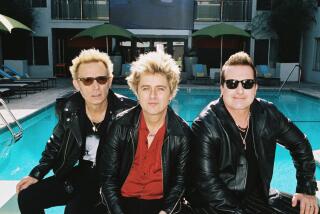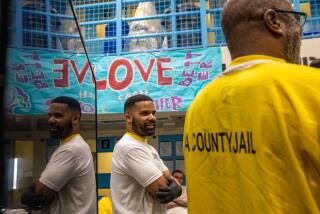Tour de Gold
- Share via
In a few weeks, cyclist Lance Armstrong will trade his Team Motorola jersey for U.S. national team colors and attend to the most important business of the summer--chasing the Olympic medal that eluded him at Barcelona in 1992 as a celebrated 20-year-old amateur.
But first he must finish the Tour de France, an approximately 2,418-mile junket through five European countries and two mountain ranges, beginning today in Den Bosch, the Netherlands, and ending with a mad sprint down the Champs Elysees in Paris on July 21.
The Tour is the pinnacle of the cycling road racing world. Most years, that is.
This is 1996 and the Olympic medal is what Armstrong wants.
“This year I would trade anything for it,” he said.
Armstrong’s chances of victory in his fourth Tour de France, he concedes, are slim. He needs more experience to unseat Spain’s Miguel Indurain, who has won the race five consecutive times.
“I’m not there yet,” he said. “And the opposition is there.”
The Olympic race is another matter. It’s his specialty--a hard, one-day race with hills. Armstrong will be armed with four motivated support riders to help him get the job done.
The 24-year-old Texan, observed former professional racer and Olympic medalist Davis Phinney, “has a certain destiny.”
But Armstrong almost walked out on his destiny in 1992 after a last-place finish in his first pro race, the Clasico San Sebastian in Spain.
A professional triathlete at 15 and two-time national triathlete champion by 18, he had been recruited to road racing by the U.S. Cycling Federation and unleashed with impressive results on the international amateur circuit. Armstrong’s abilities were visible and immense.
“He made it clear he was a huge talent,” said U.S. National Coaching Director Chris Carmichael, who developed Armstrong as an amateur and still writes his training program. “He was incredibly strong.”
Carmichael was presented with not only a young athlete who was determined to win, but with a man of character who had learned tenacity and mental toughness from his remarkable mother, Linda Walling.
Armstrong inherited unique genes from the father he has never met and doesn’t care to meet. He gained a marquee surname from a former stepfather he refuses to discuss. But it was his non-athlete mother, 17 years old and alone when he was born, who gave him the grit to excel and who taught him the most important lesson in life: Never quit.
“You’ve got to enter to win,” she told her son as he competed in track, then swimming and triathlon. “It’s the commitment you make.”
And if you can’t win?
“You’ve got to finish even if you have to walk,” she told him.
Walling, married for four years to husband John--he is the one who merited the call from Armstrong on Father’s Day--grew up with her son, and they are unabashedly supportive of each other.
She’ll say “we won” this or that race. After he won the 1993 World Championship in Oslo, Armstrong, who raced for seven hours in a drenching rain, refused to meet the King of Norway without her. Ignoring bureaucratic protestations about security complications, Armstrong stopped the milling entourage and said flatly, “This is my mother. I don’t park her at the door.”
In Europe, where women appear in the road race world only to decorate the winner’s podium, the relationship is baffling to others in the business.
“It may be different now,” said one veteran cycling journalist, who apparently is unfamiliar with the American-style youth soccer and Little League syndrome, “but his mother used to go to all his races.”
*
Armstrong’s body is nearly off the charts in terms of metabolic efficiency.
“The way he can process energy is twice as high as the average American male,” said Jay T. Kearney, senior sports physiologist at the U.S. Olympic Training Center at Colorado Springs, Colo. “Lance has the highest value we’ve recorded for any cyclist here at the lab.”
Armstrong plies his profession with what his Motorola masseur John Hendershot calls a “bomb-proof body.” His 166 pounds are packed on a 5-foot-10 frame.
“He is heavy-chested,” Kearney said. “Not as aerodynamic as some. The best thing is to be shaped like a knife blade.”
Carmichael’s first job was to curb Armstrong’s use of brute force.
“He would ride off the front of the races and try to win,” Carmichael said. “And succeed a lot. He would ride people off his wheel. He was very aggressive. He would go out and attack the course. He was good. But he did not have good tactical sense.
“Patience was the No. 1 tactic he needed to learn. You have to let the conditions of the race and the terrain take its toll before you attack.”
To build Armstrong’s endurance, Carmichael prescribed seven-hour rides. He taught Armstrong to channel his aggression and he took him to Italy to experience the cultural phenomenon of European stage racing.
“I got him to understand,” Carmichael said, “that he could be the best in the world.”
At the 1991 Tour DuPont, Carmichael introduced Armstrong to Jim Ochowicz, the Wisconsin-based general manager of Team Motorola.
He saw Armstrong’s potential and signed him for the 1992 season to race as an amateur until after the Barcelona Olympics, when he would take a professional license.
“He was very self-confident,” Ochowicz said. “If you are going to succeed at the highest degree you need to believe in yourself.”
Armstrong was primed, pumped and ready, but destiny took a detour in Spain. Instead of blazing his way into history, he placed 14th in the men’s road race.
And two weeks later, battered by high winds, torrential rain and booing fans, Armstrong chugged through the San Sebastian darkness to claim 111th place, 33 minutes behind the 110th rider.
His first professional race might have been his last had he not been encouraged by people close to him: Carmichael, his mother, European team director Hennie Kuiper, a Dutch Olympic gold medalist who was waiting for him at the finish line on that soggy day.
“I was devastated,” Armstrong said. “I felt like quitting on the spot. I was ready to get on the plane and go straight home. My coach talked me out of it. My mother talked me out of it. . . No, not so much my mother. She would have supported me no matter what I did. . . . My coach talked me out of it. He said it was just a bad day.”
The next week he won a stage of an event in Galicia, Spain, and two weeks later was second in the World Cup Grand Prix in Zurich.
“Winning a stage in Galicia made me realize that I could win professional races,” he said. “But I think that finishing second in my second World Cup race--the championship of Zurich--really made me think that I would have a place in the one-day races.”
If he had quit after the defeat at San Sebastian, he would not have become, at 21, the second-youngest world champion the next year. He would not have won the 1993 national championship or the $1-million check for sweeping the domestic triple crown of cycling or two Tour DuPonts.
He would not have had the sweet satisfaction of winning the 1995 Clasico San Sebastian, becoming the first American to win a European one-day classic.
He would not have rocketed away from the lead riders to win the 18th stage of the 1995 Tour de France in emotional homage to Motorola teammate Fabio Casartelli, who had died three days earlier when he lost control on a mountain descent.
Armstrong has a sturdy sense of self and a big house on a lake in Austin where he can water ski, talk football with friends then hit the rock club circuit. He owns a very fast car in which he burns up the Texas landscape. He has no intention of moving to Europe and becoming immersed in a foreign culture a la Greg LeMond. Not unless the Dallas Cowboys move to Paris.
More to Read
Go beyond the scoreboard
Get the latest on L.A.'s teams in the daily Sports Report newsletter.
You may occasionally receive promotional content from the Los Angeles Times.






